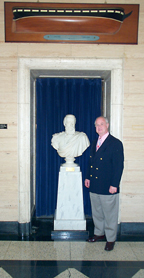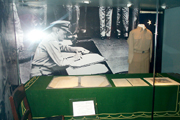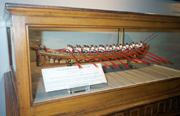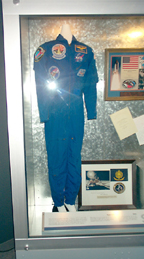The U.S. Naval Academy Museum
Enhancing esprit through common history
by Ben Miller
Not all the graduates of the U.S. Naval Academy fly off into the wild blue yonder or sail off on the deep blue sea. They also work as cryptologists, photographers, even museum curators.
Dr. J. Scott Harmon, class of 1964, jumped ship after four years — including service on a destroyer in the Gulf of Tonkin — to combine his two loves, history and the Navy. He wrote his doctoral dissertation at the College of William and Mary on the Navy’s role in suppressing the slave trade. While with the National Park Service, he helped create the National Prisoner of War Museum at Andersonville National Historic Site in Georgia.
Then, in 1998, he returned to the Academy to help meld midshipmen into leaders and to run the U.S. Naval Academy Museum.
Ask him what leadership means, and you’ll get a lesson, for Harmon is one of the breed of curators who like to get their exhibits out of glass cases to show and teach.
“Leadership is not management. It is not coercion or driving people to do what you want,” Harmon says.
“Leadership is getting people to respond in a correct way with enthusiasm. It’s getting people to focus on their jobs. It’s encouraging people to want to do something for the good of everyone” — no matter how high the cost, says Harmon. 
In his mind as he speaks are the heroes the Battle of Leyte Gulf in the Pacific in World War II, many of them trained at the U.S. Naval Academy. Out-manned, out-gunned and out-sized, American destroyers protecting aircraft carriers nonetheless steamed ahead to confront huge Japanese battleships.
How do you turn a 65-year-old museum into a school for leaders?
By bringing people to the forefront. A major renovation is doing just that, bringing classrooms, laboratories, and along with them the U.S. Naval Academy Museum, into the 21st century.
In a few years — January, 2009, to be exact — exhibits at the U.S. Naval Academy Museum will teach and display the history and tradition of leadership, naval exploration and technological change. Three- to four-minute videos will tell the stories of Naval Academy graduates who showed their leadership in both war and peace. Albert Abraham Michelson, 1873, won the Nobel Prize for Physics for measuring the speed of light. Richard E. Byrd, 1912, explored the Arctic and Antarctica. Alan Shepard, 1944, made history as America’s first astronaut in space. Jimmy Carter, 1948, won both the U.S. presidency and the Nobel Peace Prize.
Artifacts now resting in glass cases will join the heroes who used them: John Paul Jones; Matthew Calbraith Perry, who opened Japan to trade; John Worden, captain of the Monitor during the Civil War; and James Lovell and Wendy Lawrence, astronauts.
Computer-generated battle scenes will show how ships maneuvered during the great naval battles of American history. A flag that is an icon of naval lore, and whose motto animates the Navy and the Marines to this day — the Don’t Give up the Ship flag carried by Oliver Hazard Perry in the Battle of Lake Erie in 1813 — will be a centerpiece of the museum.
For the renovation of the museum and its home, Preble Hall, we taxpayers are contributing $10.5 million. The $7.5 cost of the new exhibits is being borne by private donors, most substantially the U.S. Naval Academy classes of 1946, 1947, 1950, 1951, 1952, 1956, 1958, 1966, 1971, 1982 and 1998. 
The new exhibits will be “attuned to educational programs” at the academy, Harmon says. But they’ll not be only for midshipmen. The exhibits will also explain to visitors “what this institution has been doing for 160 years,” says Harmon, and “will recruit young people to begin a life of service to their country.”
The goal of the new museum is to “enhance the spirit — the esprit — that develops in institutions when they know their common history,” Harmon says.
“Naval Academy graduates know they are part of something bigger. There is a connective tissue. They are part of a tradition that has a connection with other people,” continues Harmon.
“Public service is a noble calling. That is the message of this museum,” Harmon says. “We’re preparing leaders for many careers. The training and leadership will stand you in good stead whatever you do.”
Today’s Museum: See It Now
The U.S. Naval Academy Museum is well worth a visit before it closes for renovation in June, 2007. See it now. Then you can compare the old to the new.
Today’s museum is a ship lover’s paradise, arrayed with hundreds of model ships. These are not models made by hobbyists.
You’ll see warships of the British Royal Navy, in exquisite and exact detail. Some are more than 300 years old, others only 100 or so years old. Dockyard models of real vessels in the fleet were made for wealthy and well-connected patrons, officials and royalty.
Even more amazing are the prisoner of war ship models carved from bone by French sailors imprisoned in England. The prisoners worked with bone, human hair and anything else they could gather to create from memory ships they’d sailed and seen.
Behind them are two curators known round the world for their expertise in ship models, Grant Walker, who specializes in dockyard models, and Jim Cheever, who is himself a model maker.
For history lovers, Harmon has assembled the exhibit 100 YEARS … and forward. Audio programs, videos and real things — weapons, flags, uniforms — document the roles of the Navy, the Naval Academy and its graduates from the Spanish-American War to the space program.
The 20th century had few more significant days than September 2, 1945, when Fleet Admiral Chester Nimitz accepted the surrender of the Japanese aboard the USS Missouri. You can almost feel the vibrations when, looking at the photo of the surrender, you see the original mess table, its green tablecloth, Admiral Nimitz’s chair and the khaki uniform he wore.
On the lighter side, you’ll see the class rings of each Naval Academy graduating class.
The main gallery is old-fashioned with rows of glass cases. It can be boring walking through, but if you look at it like a treasure hunt you will find some marvelous artifacts. Look for the bright yellow dress of the color girl (and learn the tradition of the commissioning week color girls), artifacts that once belonged to John Paul Jones and gifts brought back from Japan by Matthew Perry in the 1850s.
Art lovers will find ships, seascapes, portraits and battle scenes, some by notable artists including Robert Salmon, Gilbert Stuart, Edward Moran and N.C. Wyeth.
One of few free museums in the Annapolis area, the U.S. Naval Academy Museum is a site to put on your to-see list now and in the future.
The U.S. Naval Academy Museum: Preble Hall on the grounds of the U.S. Naval Academy. 9am-5pm Mon.-Sat.; 11am-5pm Sun. Visitors need an official photo identification to enter the grounds of the Naval Academy.
